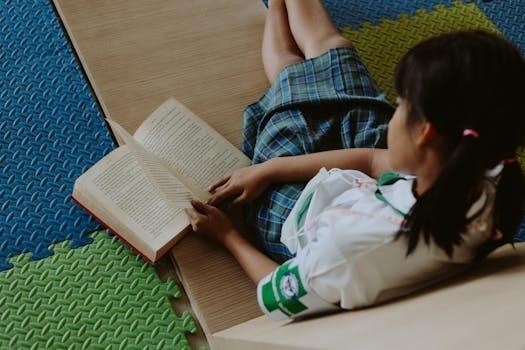
required high school reading list pdf
High school reading lists are crucial tools for educational development. These lists, compiled from resources like the American Library Association and state boards, offer a curated selection of literature. These texts aim to engage students with diverse narratives, encourage critical thinking, and expand their literary horizons.
Purpose of High School Reading Lists
The primary purpose of high school reading lists is to provide a structured approach to literary education. These lists are designed to expose students to a variety of genres, authors, and perspectives, fostering a well-rounded understanding of literature. By including works from different time periods and cultures, reading lists aim to broaden students’ worldviews and develop empathy. Furthermore, these lists aim to improve students’ critical thinking skills and analytical abilities, which are crucial for academic success. The selected books also serve as a springboard for classroom discussions and activities, enhancing comprehension and promoting active learning. Many lists also prioritize books that are culturally relevant and thought-provoking, encouraging engagement with complex social and ethical issues. Ultimately, reading lists aim to cultivate a lifelong love of reading and learning, preparing students for future academic and personal endeavors. The selection process often involves input from educators and librarians, ensuring that the chosen texts align with curriculum goals and student interests, thus creating a balanced learning experience. This also promotes intellectual curiosity.

Commonly Recommended Books
Many high school reading lists feature classics such as “To Kill a Mockingbird,” “Pride and Prejudice”, and “The Outsiders.” These books are often chosen for their literary merit, cultural impact, and relevance to teenage experiences.
“The Outsiders” by S.E. Hinton
“The Outsiders,” a frequent inclusion in high school reading lists, offers a compelling narrative of teenage life, social class, and belonging. S.E. Hinton’s novel, often encountered in 9th grade, explores the rivalries between the “greasers” and the “Socs” in 1960s America. The story follows Ponyboy Curtis, a young greaser, as he navigates the complexities of loyalty, identity, and loss. This book resonates with students due to its relatable themes of friendship, family, and the struggle for acceptance. Its enduring popularity stems from its honest portrayal of adolescence and its ability to spark discussions about social justice and empathy. It often appears on summer reading lists, encouraging students to engage with powerful literature outside of the classroom setting. “The Outsiders” is not just a story, but a reflection of the human experience, making it a vital part of high school education.
“To Kill a Mockingbird”
Harper Lee’s “To Kill a Mockingbird” is a cornerstone of high school reading lists, celebrated for its profound exploration of racial injustice and childhood innocence. Set in the Depression-era South, the novel follows Scout Finch as she witnesses her father, Atticus, defend a wrongly accused black man. This book is often chosen for its ability to introduce complex themes such as prejudice, morality, and courage to young readers. The narrative, told through a child’s eyes, allows students to grasp difficult subjects in an accessible manner. “To Kill a Mockingbird” encourages critical thinking about social issues and the importance of empathy. Its presence on reading lists reflects its lasting impact on literature and its relevance to contemporary conversations about equality. The novel remains a vital tool for fostering thoughtful and engaged citizens, making it a critical addition to any high school curriculum.
“Pride and Prejudice”
Jane Austen’s “Pride and Prejudice” is a frequent choice on high school reading lists, esteemed for its witty dialogue and exploration of social norms in 19th-century England. The novel centers on the lives of the Bennet sisters, particularly Elizabeth, and their pursuit of marriage in a society driven by social status and wealth. The complex relationship between Elizabeth and Mr. Darcy serves as a central theme, highlighting the dangers of first impressions and the importance of personal growth. This book provides valuable insight into the societal pressures and expectations of the time. “Pride and Prejudice” offers students a chance to analyze themes of class, gender, and reputation. Its enduring popularity and literary merit make it a staple for high school English classes, offering both entertainment and intellectual challenge, promoting discussions on societal structures.

Grade-Specific Reading Lists
High school reading lists are often tailored to specific grade levels, ensuring age-appropriate content. Ninth grade might focus on short stories, while twelfth grade explores classic literature. These lists are designed to promote growth.
9th Grade Short Story Selections
Ninth-grade reading lists commonly feature short story selections designed to introduce students to diverse narrative styles and themes. These stories often serve as accessible entry points into literary analysis, allowing students to develop critical reading skills. Some frequently included short stories are “Lamb to the Slaughter,” a suspenseful tale by Roald Dahl, and “The Interlopers,” a story of feuding neighbors by Saki. These stories can provide a good base for discussing irony, suspense, and character development. “The Scarlet Ibis” is also a popular choice for its poignant exploration of sibling relationships and loss. These stories are chosen for their relatability, thematic depth, and ability to spark meaningful classroom discussions, laying a solid groundwork for students to appreciate longer, more complex texts in their future studies. These short stories also tend to be more engaging for students and easier to read, which also helps them build a love for reading.
12th Grade Literature List
The 12th-grade literature list often includes complex and thought-provoking works, preparing students for college-level reading. This list typically features classic novels and plays that explore sophisticated themes and offer deeper insight into the human condition. Examples include Mary Shelley’s “Frankenstein,” a gothic novel that delves into the dangers of unchecked ambition, and Shakespeare’s “Hamlet” or “Macbeth,” which are tragedies that explore the human psyche. “Wuthering Heights” by Emily Brontë is another common selection, known for its passionate and complex characters, while “Crime and Punishment” by Fyodor Dostoevsky examines the consequences of moral transgression. Additionally, Sophocles’s “Oedipus Rex” is also a classic choice, exploring themes of fate and free will. These works are chosen to engage students in advanced literary analysis, critical thinking, and a deeper appreciation for literature.

Summer Reading Programs
Summer reading programs encourage students to continue engaging with literature. These programs often include recommended reading lists to foster a love of reading, promote discussion, and ensure students are prepared for the upcoming school year.
Summer Reading Encouragement
Summer reading is a wonderful opportunity to explore new worlds through books. It is a time to dive into genres and authors you might not encounter during the regular school year. Participating in summer reading programs can help prevent learning loss and keep your mind sharp. Many schools provide lists of recommended books, but don’t feel limited to those – choose books that genuinely interest you. When you return to school, you’ll have the chance to share your reading experiences with your peers, discussing what you liked and disliked, and celebrating what you discovered through reading. It’s a chance to connect with stories, characters, and ideas, and to cultivate a lifelong love for reading. Make this summer a journey into the literary world by actively engaging with the books you choose. Your summer reading could lead you to favorite authors and unforgettable tales!

Resources for Reading Lists
Compiling reading lists often involves consulting sources like the American Library Association and the International Reading Association. State reading lists also provide valuable resources for educators and students seeking recommendations.
Compilation Sources and Organizations
The creation of comprehensive high school reading lists often draws upon a variety of reputable sources and organizations. The American Library Association (ALA) is a key contributor, offering guidelines and recommendations for literature across various grade levels. The International Reading Association (IRA) also plays a significant role, promoting literacy and providing resources for educators to develop well-rounded reading programs. Additionally, state education departments frequently publish their own reading lists, aligning with specific curriculum standards and educational goals. Project Lit Community also offers a network of student and teacher recommendations. These organizations and sources work to provide a balanced selection of classic and contemporary works, ensuring that students are exposed to diverse voices and perspectives. These lists are not static; they are continually reviewed and updated to reflect current literary trends and educational needs. By utilizing these varied resources, educators can create reading lists that are both engaging and academically enriching for students. Furthermore, these lists often include a range of genres and authors to ensure that all students can find books that resonate with their interests. This collaborative approach ensures that reading lists are carefully considered and well-supported.


Leave a Reply
You must be logged in to post a comment.